by Andrea Watts
Introduction
Clown loaches are my favourite aquarium fish. They are colourful, active and have an agreeable nature. These attributes make them an ideal addition to most fresh water aquaria. This article reflects my experiences with clown loaches with particular emphasis on the various patterns that I have encountered. Hope you enjoy my account of these very personable little fish.
Common Name: Clown loach
Scientific name: Botia macracantha
Size (cm) M/F: Up to 30cm both sexes (rarely seen in aquarium examples)
Habitat: They originate from large still and slow-flowing rivers in Borneo, Sumatra and the Sundra Islands. The fin colour will determine their origin; all the ones I have seen are from Borneo. The rivers have a sand substrate, and are quite thickly vegetated and littered with fallen branches. Hence the tank should reflect this arrangement.
<strong>Temperature Range:</strong> 24C - 27C (Avoid "raw" water at all costs).
Min. Tank Requirements: To get the best out of these guys, I would recommend a tank of at least 250L. As they do best in groups, the larger the tank the better.
Food: Omnivorous, not fussy at all. They love pellets (especially shrimp based), flake, blood worm and most vegetables.
Breeding: Not viable in the home aquarium.
Background
It has been suggested that the name "clown" loach is derived from their striking colour and playful antics. They mostly originate from Borneo and Sumatra, where they live in flowing and still waters. Due to the geographical isolation of these two populations, certain colour differences are a result of bio-diversity. These variations will be discussed later. Kalimantan also has a population of clown loaches although they are not as common in the aquarium trade.
The general colouration, exhibited by these beautiful fish, is bright orange. Arguably, they are the most colourful and best natured loaches available to aquarists. The body is usually marked with 3 broad, wedge-shaped bands of black. The red and black colour on the tail and fins are environmentally determined. Variable colour and markings will be discussed later. Clowns grow to a maximum length of about 30 cm (or 1 foot in old terms). It is rare to see specimens attain this size in aquariums and full grown wild specimens are becoming scarce. The body is somewhat elongated, laterally compressed with an arched spine and relatively flat belly line. The down-turned mouth supports four pairs of small barbels that are situated on the lower jaw. The "lips" are thick and fleshy, thus soft substrate should be used in the aquarium.
Generally speaking they are hardy and long-lived, although they are intolerant of "raw" water. I have kept them in many different water conditions, ranging from quite soft to very hard water. Regular partial water changes are conducive to keeping happy, healthy fish.
Clowns are gregarious by nature i.e. they prefer the company of other clowns. Groups of at least 3 or more is essential to maintaining the well-being of clown loaches. As mentioned in the above overview, they prefer an environment that provides adequate hiding places. They rest upon logs and substrate, quite often in such a manner that it causes alarm for their owner. Many a time I have sprung up from a chair to tap the glass, only to see the offender spring back to life and swim off. This "resting" position is typical of the species. They are known to school with other fish of similar colour and markings; for example tiger barbs. My [i]Distichodus sexfasciatus[i] schools with them all day! "Whiskering" of other fish is common but it appears to have nuisance value only. They spend most of the day schooling together and foraging through the substrate.
Clown loaches enjoy a wide variety of foods. Being mostly carnivorous, they seem to prefer high protein commercial pellets, but relish blood worms. I tend not to add live worms to the tank for fear of introducing parasites. Vegetables are also a welcome dietary addition. I regularly supplement feeding with partially cooked pumpkin, broccoli, zucchini and peas. Fresh lettuce is also greedily accepted. The territorial "clicking" noises exhibited as they feed are quite audible to the human ear. Their particular fondness for snails makes them an ideal biological control alternative to chemical pesticides.
Variations in colour and pattern
As has been discussed already, basic colouration for this species is orange with black bands. The amount and positon of red in the finnage is determined by origin. These variations are often only detectable when fish from different locations are placed side by side for comparison.
Sumatran loaches have relatively intense colouration. The colour contrasts are crisper than those seen in the "duller" fish from Borneo. The most obvious difference between these geographically separated populations is detected in the pelvic fins. Clown loaches from Borneo exhibit a basal and central black area, with a reddish orange leading ray. Sumatran fish have a solid reddish orange fin without any black. Other noted differences include less colouration of the dorsal and anal fin leading edges and a lack of stripe continuation into the caudal peduncle of Sumatran fish. Fish sourced from Kalimantan are similar to those from Sumatra, however the red colouration is more intense. The subtle colour variation between Sumatran and Kalimantan aches could be attributed to habitat. Sumatran loaches live in murky, turbid waters, whereas those from Kalimantan prefer the brown, tannic waters of tributaries. Perhaps the dissolved organic matter of the black water environment helps accentuate the reddish/orange colours in the fish. All fish that I have seen available in Australia appear to be from Borneo stock *edit: I just found a Sumatran!*
The patterns that arise within the black banding on the these loaches are fascinating. I am collecting as many different types that money and source allows me. Interestingly, these spots, shapes and stripes can "shift". By this I mean that they can vary the intensity of black in the boundaries and actually slightly change/move the shape of the markings. Fish often grey out" when fighting over leadership or food. There seem to be 7 basic designs, with variations amongst each group. The following are examples that I currently have in my aquaria:
1. "normal" pattern standard 3 stripes

2. 4 stripe (includes broken stripes and saddle combinations)
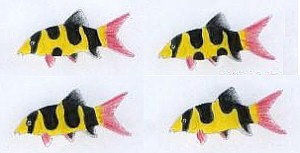
3. "jigsaw"

4. second stripe "saddle"/ broken stripe

5. third stripe "saddle"/broken stripe

6. spotted

7. joined stripe

The Trade of Clown Loaches
Traditionally clown loaches were harvested from the wild for food and aquarium trade. Approximately 20 million fish are exported annually. Due to their popularity, many small (preferably 2 - 8cm) loaches are captured every year and dispersed world wide. Interestingly, Indonesia has posed a ban on the export of fish larger than 10cm. This policy is hoped to protect breeding adults and make captive breeding by external groups more difficult. Larger specimens are considered to be unsuitable for aquarium life (due to their carnivorous nature and adaptability difficulties) hence large breeding populations are generally left intact. Young fish are only caught during the high water seasons whilst they are abundant and highly concentrated in one area. This makes trapping easier and the economics of such programs are therefore viable during this time. Juveniles adapt easily to prepared foods and captivity.
Collection procedures differ slightly between Borneo and Sumatra. In Sumatra, clowns are caught by using perforated bamboo poles stuck into the river bank substratum. This allows loaches of a preferred size to enter the cavities of the bamboo poles. The poles are set at a pre-determined distance apart, where they are later collected by boat. The contents are emptied directly into the bottom of the boat that is filled with water. The loaches are then taken back to a holding facility where they are sorted according to size and sold to a wholesaler.
In Borneo, a slightly different collection method is implemented. Bamboo poles are bundled and tied together then sunk with stones. Rope is used to attach the trap to stakes that are driven into the river bed. When the trap is retrieved from the river, any loaches that have taken refuge inside the bamboo configuration are shaken into a collection vessel. This shaking action is more detrimental to the well-being of the loaches than the method adopted in Sumatra.
Most fish caught in Kalimantan are used for food and few numbers are exported for aquarium trade.
Although the clown loach trade has heavily exploited numbers in the wild, relatively large populations still exist. This is mainly due to the efforts of the individual governments to control numbers that are caught and the fickle nature of the market.
Although some fisheries in Thailand have capitalised on the artificial breeding of these fish, generally this practice is not viable at this point in time. Before the pressure is taken off wild populations, huge technical advances in the field of aquaculture must be reached. Hopefully this is in the "not too distant future". It would be disastrous to lose this fish from the wild. Environmental disasters (natural and human induced) continually threaten the clown loach in the wild. We don't need fisheries mismanagement also contributing to their demise.
Currently massive aquaculture operations in Asia have gone a long way to lessen the burden on native stocks. The majority of clown loaches exported today are captively bred using hormone induced spawning techniques.
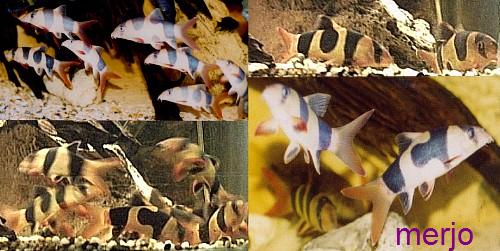
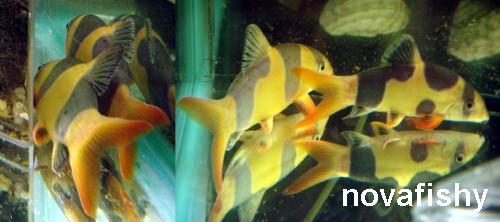
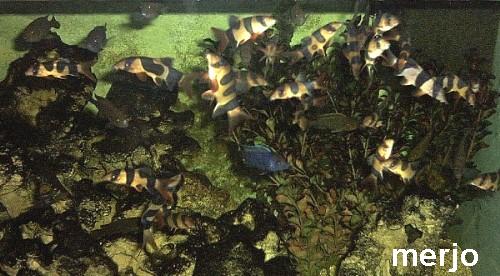
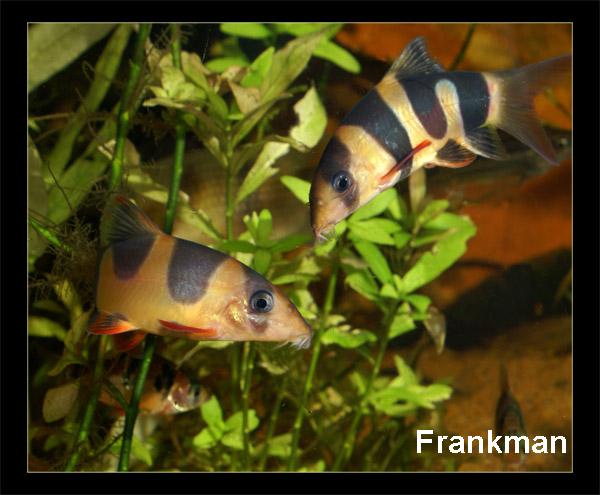
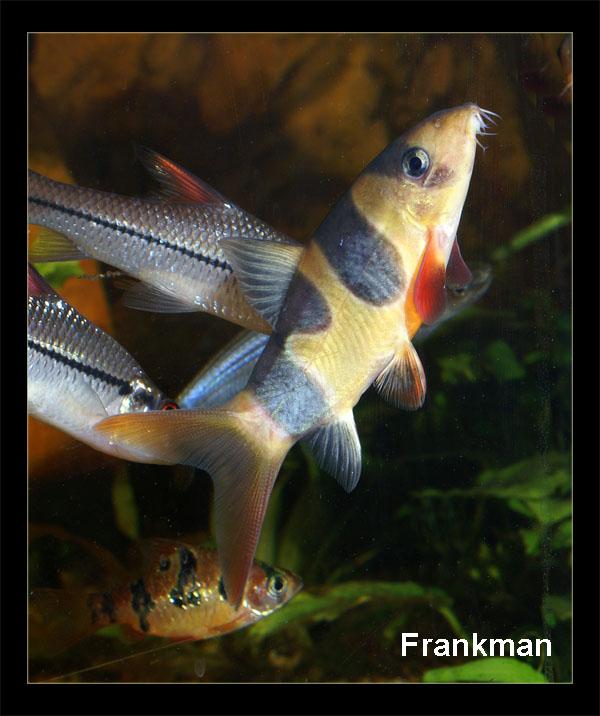
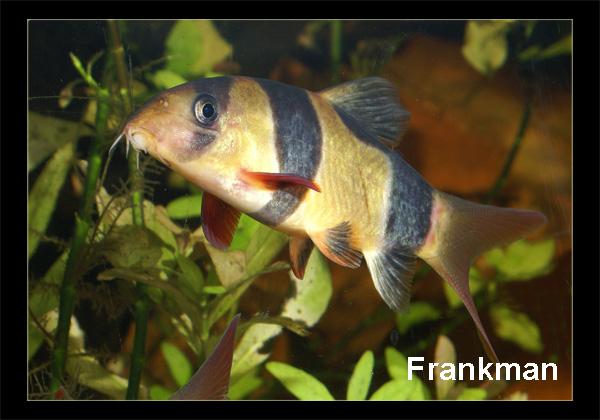
Credits for this article include
http://www.loaches.com/index.html
http://rmbr.nus.edu....more.html#clown




 This topic is locked
This topic is locked



